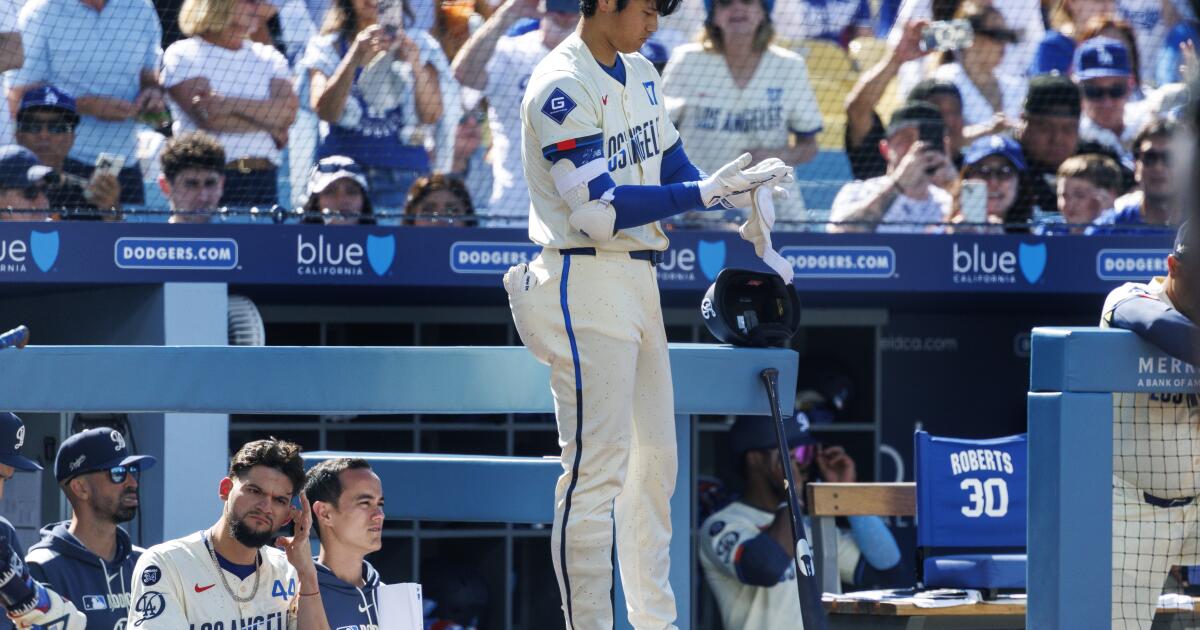Shohei Ohtani takes rare on-field BP amid playoff slump, downplays impact of two-way role
At 5:37 p.m. Wednesday, Michael Buble’s “Feeling Good” blared from the Dodger Stadium speakers.
Shohei Ohtani came strolling to the plate with a bat in his hands.
There was no one in the stands, of course. Nor an opposing pitcher on the mound. The Dodgers, on this workout day after returning from Milwaukee, were still some 22 hours away from resuming their National League Championship Series against the Brewers. For any other player, it would have been a routine affair.
Ohtani, however, is not just any player.
And among the many things that make him unique, his habit of almost never taking batting practice on the field is one of the small but notable ones.
Which made his decision to do so Wednesday a telling development.
Over the last two weeks, Ohtani has been in a slump. Since the start of the NL Division Series, he is just two-for-25 with a whopping 12 strikeouts. He has been smothered by left-handed pitching. He has made poor swing decisions and failed to slug the ball.
Last week, manager Dave Roberts went so far as to say the Dodgers were “not gonna win the World Series with that sort of performance” from their $700-million slugger.
Thus, out Ohtani came for batting practice on Wednesday in the most visible sign yet of his urgency for a turnaround.
“The other way to say it is that, if I hit, we will win,” Ohtani said in Japanese when asked about Roberts’ World Series quote earlier Wednesday afternoon. “I think he thinks that if I hit, we will win. I’d like to do my best to do that.”
In Roberts’ view, Ohtani has already started improving from his woeful NLDS, when he struck out nine times in 18 trips to the plate against a left-handed-heavy Philadelphia Phillies staff that, as president of baseball operations Andrew Friedman emphatically put it, had “the most impressive execution against a hitter I’ve ever seen.”
In Game 1 of the NLCS against the Brewers, Ohtani was 0-for-two but walked three times; twice intentionally but another on a more disciplined five-pitch at-bat to lead off the game against left-handed opener Aaron Ashby.
The following night, he went only one-for-five with three more strikeouts, giving him 15 this postseason, second-most in the playoffs. But he did have an RBI single, marking his first run driven in since Game 2 of the NLDS. He followed that with a steal, swiping his first bag of the playoffs. And earlier in the game, he scorched a lineout to right at 115.2 mph, the hardest he’d hit a ball since taking Cincinnati Reds pitcher Hunter Greene deep in the team’s postseason opener.
“The first two games in Milwaukee, his at-bats have been fantastic,” Roberts said Wednesday, before heading out to the field and watching Ohtani’s impromptu BP session.
“That’s what I’ve been looking for. That’s what I’m counting on,” he added, while noting the careful approach the Brewers have also taken with the soon-to-be four-time MVP. “You can only take what they give you. So for me, I think he’s in a good spot right now.”
Shohei Ohtani puts the ball in play in the third inning during Game 4 of the NLDS.
(Gina Ferazzi / Los Angeles Times)
Ohtani’s overall numbers, of course, continue to suggest otherwise. His .147 postseason batting average is second-worst on the team, ahead of only Andy Pages. His seven-game drought without an extra-base hit is longer than any he endured in the regular season.
“The first thing I have to do is increase the level of my at-bats,” Ohtani said in Japanese. “Swing at strikes and not swing at balls.”
On Wednesday, Ohtani’s slump also led to questions about his role as a two-way player, and whether his return to pitching this season (and, this October, doing it for the first time in the playoffs) has contributed to his sudden struggles at the plate.
After all, on days Ohtani pitched this season, he hit .222 with four home runs but 21 strikeouts. On the days immediately following an outing, he batted .147 with two home runs and 10 strikeouts.
His current slump began with a hitless, four-strikeout dud in Game 1 of the NLDS, when he also made a six-inning, three-run start on the mound.
And in days since, Roberts has acknowledged some likely correlation between Ohtani’s two roles.
“[His offense] hasn’t been good when he’s pitched,” Roberts said following the NLDS. “We’ve got to think through this and come up with a better game plan.”
Ohtani, on the other hand, pushed back somewhat on that narrative during Wednesday’s workout, in which he also threw a bullpen session in preparation for his next start in Game 4 of the NLCS on Friday.
While it is “more physically strenuous” to handle both roles, he conceded, he countered that “I don’t know if there’s a direct correlation.”
“Physically,” he added, “I don’t feel like there’s a connection.”
Instead, Ohtani on Wednesday went about fixing his swing the way any other normal hitter would. He went out on the field for his rare session of batting practice. Of his 32 swings, he sent 14 over the fence, including one that clanked off the roof of the right-field pavilion.
“Certainly, there’s frustration,” Roberts said of how he’s seen Ohtani handle his uncharacteristic lack of performance.
But, he added, “that’s expected. I don’t mind it. I like the edge.”
“He’s obviously a very, very talented player, and we’re counting on him,” Roberts continued. “He’s just a great competitor. He’s very prepared. And there’s still a lot of baseball left.”

